Our central kitchens are places where various menu items are prepared, using a combination of manual work and machine processing.
Along with their high efficiency, our central kitchens are designed to ensure that our dishes taste consistently delicious at every restaurant in Japan.
Hygiene Management System for Our Central Kitchens Based on ISO22000
Our central kitchens, responsible for the primary ingredient processing and logistics, are installed with cameras to thoroughly ensure that employees wash their hands when entering production line areas and after using the restroom, and conduct checks and provide guidance 24 hours a day. We also take measures to ensure that viruses are not carried into our central kitchens, by asking employees to declare and record the health status of not only themselves but also those who live with them.
In addition to establishing a hygiene management system in line with ISO22000, we have also established quality standards for producing safe products. All of our central kitchens obtained ISO22000 certification in December 2020.
Preventing Bacteria and Foreign Substance Contaminations
There are ten central kitchens located throughout Japan that manage the ingredients used by Skylark Group and perform primary processing. In addition to wearing white coats, caps, masks and boots, employees follow strict manuals with rules regarding temperature checks, careful hand washing, sterilization of the soles of boots, dust removal by air shower, and regular stool inspections. Strict hygiene checks are carried out every day for those who enter the central kitchens, as well as for the ingredients themselves.
Defrosting Method that Combines Good Taste and Time Savings
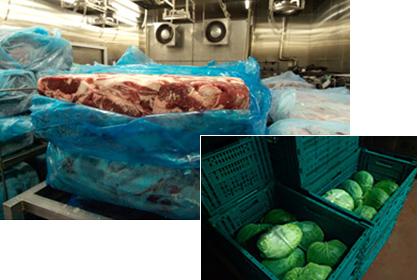
Flavor is retained during thawing using low-temperature humidifiers.Vegetables are also stored at low temperatures.
Meat procured in a frozen state is thawed both on the outside and in the center simultaneously by steam from a low-temperature humidifier that raises and lowers the temperature while spraying hot water into the thawing unit. Using this method, meat that would take three days to thaw at room temperature can be rapidly thawed overnight, to a temperature at which it can be made into a hamburger. As a result, it is possible not only for us to thaw meat efficiently but also to prevent the outside from becoming too soft and excessive meat juices being released (drip loss), leading to a loss of taste, as is likely to occur during natural thawing.
Vegetables that we procure are also stored temporarily at low temperatures, maintaining their freshness.
Realizing Efficiency and Food Safety with Fusion of Machines and Expert Skills
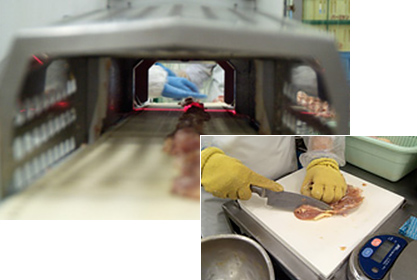
Meat is scanned and cut using lasers.Some cutting requires a human touch.
In our central kitchens, we prepare various ingredients. This process is called primary processing. In primary processing, things are not left entirely to either machines or human workers. We judge the strengths of human eyes and hands, and those of machines, and allocate job appropriately between them.
In the case of chicken for use in karaage (Japanese-style fried chicken), for example, we use a machine that scans the shape of the meat with a laser and cuts it to uniform weight to increase efficiency, cutting around one ton of chicken meat a day.
On the other hand, single-piece chicken steaks differ in thickness depending on the meat used, so each piece is cut by hand. This way, meat of any shape can be cooked and served deliciously by heating it for the same number of seconds at store kitchens.
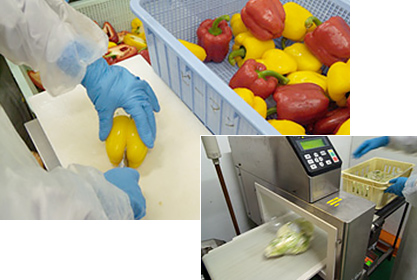
The condition of vegetables is checked by workers using their own hands and eyes. We also check thoroughly for contamination by foreign substances.
Meanwhile, vegetables such as cabbage are cut into chunks manually by workers using a kitchen knife. This is so workers can check the condition of the vegetables for damage, using their own hands and eyes. After that, the chopped vegetables are washed by machine, and finally subjected to a metal inspection and double checked by both machine and human eyes for contamination.
By consolidating primary processing for food preparation in our central kitchens, we also seek to increase the skills of our staff. Delicate skills needed to cook delicious food, in bulk and without waste, are being honed every day.
Sauces and Dressings are Also Handmade
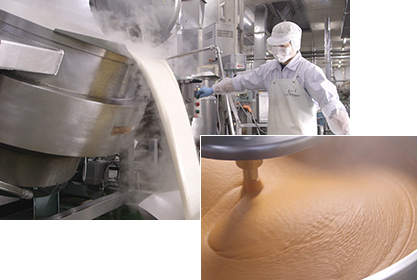
More than 20 kinds of handmade sauces and dressings are prepared fresh every day, using large 600-liter pots.
Sauces such as the demiglace sauce that compliments and enhance the delicious flavor of meat dishes, and the delicious dressings served with our salads and vegetables are actually made by hand.
Demiglace sauce is also the base for many other sauces, so it is made many times a day, in a large 600-liter pot. More than 20 kinds of dressings, such as ponzu vinegar and sesame sauce, are made in our central kitchens, with the mixing method switched by machine for each dressing.
Handmade sauces and dressings are both cheaper and tastier than buying ready-made items.
This kind of commitment is also unique to Skylark Group.
Taking the Time and Effort to Deliver Ingredients Fresh to Stores Nationwide
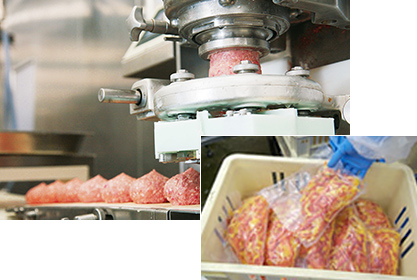
We take time and effort to deliver primary processed food to our stores the same day.
Although we avoid using ready-made frozen foods as much as possible, taking the time and effort to prepare vegetables and meat from scratch at our stores would take time, and the taste would be inconsistent between locations.
In order to shorten cooking times and achieve consistent flavor, we carry out primary processing at our central kitchens.
To maintain the freshness of our primary processed ingredients, orders placed by stores the night before are manufactured and delivered chilled on the same day.
Various Initiatives to Support Our Central Kitchens
Safe and Delicious Dishes are Made Using Handmade Machines
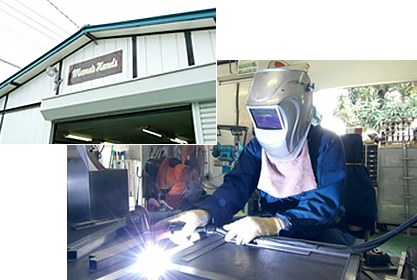
Mama's Hands produces handcrafted machines.Its staff are also experienced cooks
On the same premises as our central kitchens, there is a workshop called Mama's Hands, which makes, repairs and improves the machines that operate in our central kitchens. The workshop staff who listen to the opinions of kitchen workers and consider the best solutions together while fabricating these machines are also experienced cooks.
Mama's Hands produces various machines by hand, in the same way as our handmade menu items, working around the key theme of how to make delicious food and reduce the workload placed on kitchen staff.
Proud Work of Mama's Hands (1): Unique tasting sauce! "Boiled Egg Crushing Machine"
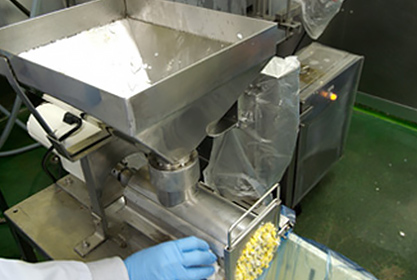
Crushed boiled eggs are made into tartar sauce.
When a boiled egg with the shell still attached is placed inside our convenient egg crushing machine, the machine automatically peels off the shell and finely crushes the yolk and white of the egg with the power of motorized rotation. Crushed boiled eggs are used mainly as a raw ingredient for making tartar sauce. This machine embodies our desire to make sauce with our own unique taste! The machine can crush nearly 2,000 eggs per hour.
Proud Work of Mama's Hands (2): Reproducing artisanal craftsmanship "Handmade Tofu Making Machine"
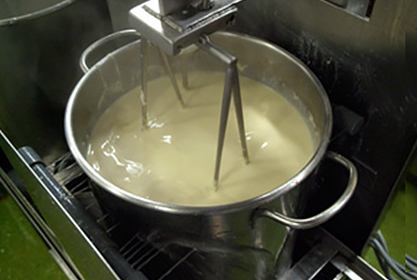
Reproduces the hand movements of tofu artisans.
To reduce costs and improve quality, we wanted to make tofu by hand instead of buying it from a tofu dealer. Therefore, we sent our staff to train with a tofu craftsman and developed a machine that moves in the same way as the hands of such tofu craftsman. This machine mechanizes and simulates the movements of a tofu craftsman, such as subtle adjustments when adding and mixing in bittern. The machine makes around 2,500 individual 180g packs of tofu per hour.
If we order machines to be made from scratch by an external contractor, our costs will increase, but if we make them ourselves, then we can lower costs. Even when there is a revision to our menus, we can make the optimal machine by ourselves, which leads to consistent quality and efficiency.